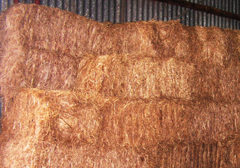
Farmer’s fever, also called organic dust toxic syndrome (ODTS), is caused by breathing in dust that contains moulds from spoiled plant materials such as baled hay, stored grain or silage. It is a common respiratory illness in farmers, particularly those working with grain, hay, silage and confined animals. The symptoms are a fever and flu-like symptoms which occur 4 to 12 hours after exposure to contaminated dust.
The symptoms of farmer’s fever will usually disappear within one to three days after you are no longer exposed to the dust. However subsequent exposures may increase the risk of a range of respiratory symptoms. (Farmer’s Lung, 2016). ODTS is often misdiagnosed, so it is important to tell your doctor about any recent dust exposures you may have had.
You can reduce your risk of developing ODTS by minimising hay spoilage, wetting down dusty areas and wearing a mask or respirator.
Fast facts:
- Organic dust toxic syndrome or farmer’s fever is caused by inhaling mouldy dust.
- Farmer’s fever is a common respiratory illness in farmers.
- Tell your doctor if you’ve been exposed to dust and you have flu-like symptoms.
References used for this topic page
More information:
Centers for Disease Control (US)
Preventing organic dust toxic syndrome [PDF 33kb]
PennState Extension
Farm Respiratory Hazards (2014)
Clinical care:
Canadian Centre for Occupational Health & Safety
Farmers Lung (2016)
Research & reviews:
Occupational and Environmental Medicine (2018)
Determinants for asthma in farmers with special reference to odts (organic dust toxic syndrome)
American Association of Swine Veterinarians (2005)
Organic dust toxic syndrome: a non-infectious febrile disease after exposure to the hog barn [PDF 453kb]
Agrifutures Australia (2006)
Respiratory illness in farmers (free PDF download)
International Journal of Environmental Research & Public Health
Agricultural Dust Exposures and Health and Safety Practices among Western Australian Wheatbelt Farmers during Harvest
|
|